What is Gastric Dilatation and Volvulus (GDV)?
Gastric Dilatation and Volvulus (GDV) syndrome is also called dog bloat. It occurs in dogs when the stomach dilates and twists into an abnormal position (gastric volvulus). It is a life-threatening condition and needs emergency GDV surgery.
The dilation can occur in any dog. Typically pressure in the stomach can be relieved by vomiting or burping. But, when the stomach then also twists or rolls, it closes the openings in and out of the stomach. The gas cannot be evacuated and causes a hazardous and painful condition for the dog: Gastric Dilatation and Volvulus.
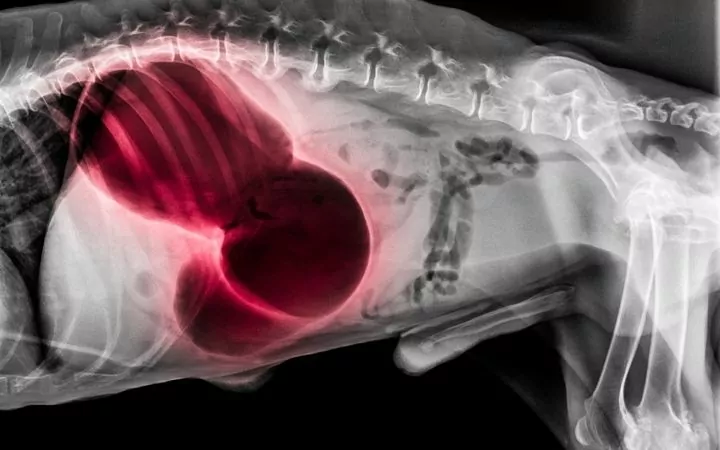
The Risk Factors Associated with GDV
Gastric Dilatation and Volvulus (GDV) can happen in any dog. GDV is a complex condition and is caused by a lot of factors. It is easy to describe the physical reaction: The stomach twists around the intestines’ longitudinal axis.
The gas dilation may happen after or before the twists, but the stomach’s expansion and then the dog moving around causes the twists.
Even vets and experts aren’t entirely sure what causes the flip, twist, or bloat for sure. Statistics show that GDV is more common in deep-chested, large dogs and dogs with broad shoulders. Some of the breeds more likely to suffer from GDV are:
- Basset Hounds
- Boxers
- Great Danes
- Weimaraners
- German Shepherds
Preoperative Treatment and Stabilization
Stabilization of your dog is the most crucial step before GDV surgery. It will often include intravenous fluid and oxygen to stabilize and prevent hypoxia (lack of oxygen to the tissues).
Gastric decompression to combat the dog’s bloat is often the next step to release the air that accumulates in the stomach. This can either be done by a tube down through the esophagus or with a catheter from the outside.
When your dog is ready for GDV surgery and general anesthesia, it depends on how quickly it can be stabilized. Your veterinarian should determine it on an individual basis.
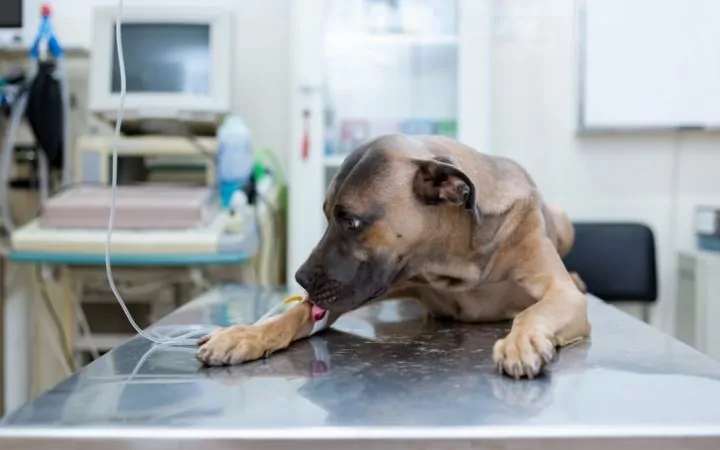
Signs and Symptoms
The initial clinical signs can be quite subtle. In the beginning, they are often similar to symptoms seen in dogs with simple abdominal pain or where your dog’s stomach is hard. These symptoms include, but are not limited to:
- Standing and stretching excessively.
- Restlessness and pacing
- Drooling
- Retching without producing anything
- Anxious looking at and licking the abdomen
- The dog’s stomach is making noises.
The GDV condition will progressively worsen over a short period of time. As it gets worse, symptoms will also worsen to:
- Panting
- Abdominal distension (bloated stomach)
- Weakness
- Collapse and even death
If your pet is displaying any of the symptoms mentioned above, a veterinarian should evaluate it as soon as possible. The stabilization and GDV surgery have the best prognosis if performed early in the course of the condition.
As the stomach starts dilating and expanding, the pressure will increase. The increased pressure can lead to several secondary consequences like:
- Inadequate blood flowing from the abdomen to the heart.
- Loss of blood flow to the lining of the stomach.
- Rupture of the stomach wall.
- Pressure on the diaphragm preventing the lungs from expanding adequately.
All in all, the entire body will start suffering from poor ventilation, lack of blood flow, and then the death of cells in lots of different tissues. Especially the liver, kidneys, and vital organs could be severely affected.
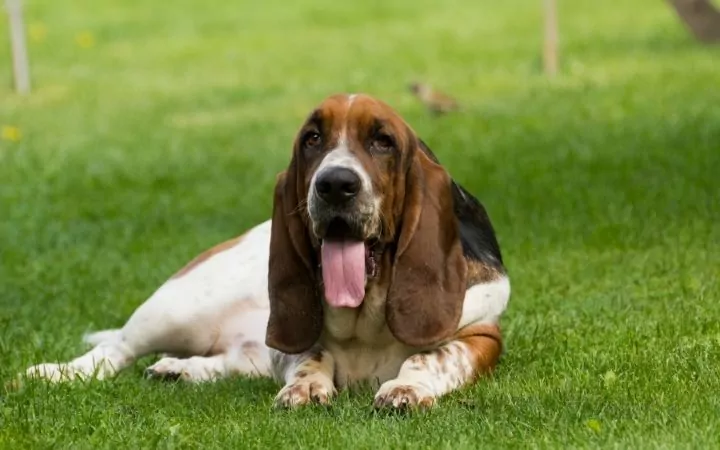
Dietary Risk Factors
Other factors that are suspected of increasing the chances of GDV include physical risks, especially when eating:
- Eating and drinking quickly.
- Eating kibble solely – produces more gas.
- Having one big meal.
- Physical activity after eating.
- Being older than seven years.
- Being male.
No matter what causes the GDV, it is an emergency condition requiring immediate veterinary care and treatment. If you suspect your dog of suffering from GDV (especially if it appears nauseated, with unproductive retching and distension of the stomach), contact your local emergency veterinary center.
The Goals of Gastric Dilation and Volvulus Surgery
Most veterinarians will recommend bloodwork to determine what’s causing the dog’s metabolic disturbances and rule out any other diseases that may be present.
A definite diagnosis is made based on X-rays, where a distended stomach can be visualized or sometimes even a volvulus.
GDV surgery will be needed if the stomach is twisted, as a tube cannot pass through the esophagus and into the stomach. The surgery involves exploring the abdomen and then a de-rotation of the stomach, back to its usual location.
The surgeon will often remove parts of the stomach that has been destroyed due to lack of blood and oxygen and parts of the spleen that may have been injured. Lastly, the stomach can also be sutured to the body wall to prevent it from twisting again in the future. This is, however, dependent on the severity of the case.
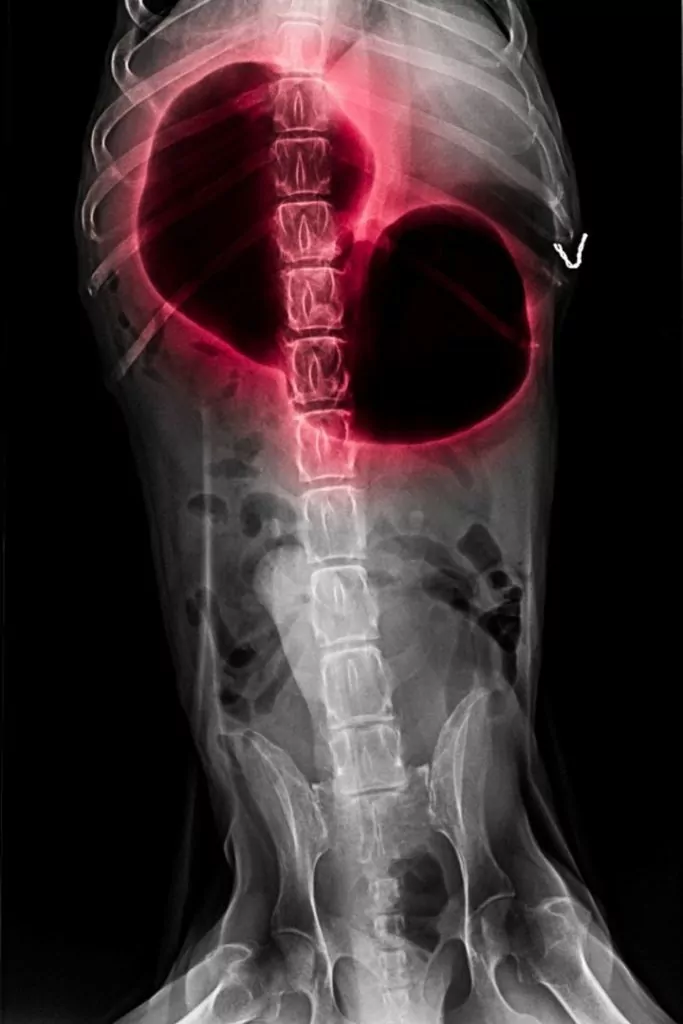
Complications of Bloat Surgery
It is essential to be aware that Gastric Dilatation and Volvulus surgery isn’t always successful. Complications during GDV surgery and after can include:
- Arrhythmias (irregular heartbeat) due to decreased blood flow to the heart
- Death
- Intermettient vomiting
- Post-operativ gastric ulceration
Notably, a recurrence of gastric dilatation can also happen. If the stomach has not been sutured to the abdominal wall, it can get loose, and the GDV can happen again.
Aftercare
Post-surgical care involves the following:
- Antibiotics, if there are signs of infection.
- IV fluid therapy.
- Monitoring the dog’s respiration and heart.
When getting the dog home, the most important thing is to reduce Gastric Dilation and Volvulus’s risk factors in the future. You should make yourself aware of the risk factors (mentioned above) and try to avoid them by:
- Let your dog rest for roughly an hour after eating.
- Give your dog two-three smaller meals per day instead of one.
- Make sure your dog always has clean water available.
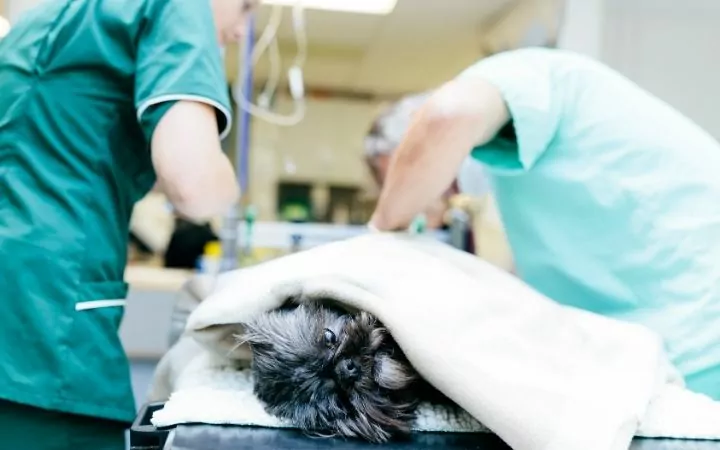
GDV Prognosis
Without quick medical intervention, Gastric Dilation and Volvulus can cause death. It is also important to note that death can occur, even after treatment and surgery. It all depends on the dog’s conditions during and after GDV surgery. The best indicator of a good prognosis is a quick treatment. Dogs that recover well seven days after surgery will have an excellent survival chance.
Recurrency frequently happens in up to 80% of dogs that have suffered from GDV before. Therefore, it is essential to be aware of the risk factors to prevent it from happening again.
Summary
Gastric Dilation and Volvulus is a severe and dangerous condition all dog owners should be aware of, especially if you have a large dog who tends to eat large portions of food fast.
So if your dog is experiencing any of the mentioned symptoms, it is always an excellent idea to give your emergency vet a call. With quick intervention, your best friend is far more likely to fully recover and be running around again in no time.
